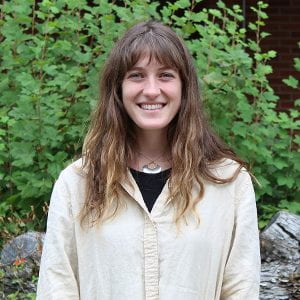By: Leslie O’Donnell
With new staff and new plans in place, the Oregon Coast Public Art Trail is on the path to a more promising future.
Marcus Hinz, executive director of the regional marketing group Oregon Coast Visitors Association (OCVA), said he has hired three contractors to inventory public art along the entire coast, one for the north, one for the central coast and one for the south. By the end of spring, the goal is to have identified 80 to 90 percent of the public art along the Oregon coast.
Hinz said public art is defined as art that is accessible 24/7 without fees or admission charges. While murals and sculpture make up much of public art, OCVA will also be documenting what Hinz termed “obscure” art, such as artistic benches or ornate manhole covers.
Public art is a “soft” way to get people interested in coastal communities, Hinz explained. The public art trail is meant to be a shoulder season marketing campaign, he noted.
“Public art is a ‘soft sell,’” he said. “The whole point of an art trail is economic development.”
He explained that when people get interested in visiting an area to view public art, they can then be introduced to museums, theaters, galleries, art studios and other venues in the same communities.
While planning for an Oregon Coast Public Art Trail has been going on for several years, Hinz is optimistic about what is happening now. Acknowledging that they have not made a lot of progress recently due to multiple staff changes, OCVA has changed its strategy so that each newly hired contractor lives in the area he or she is responsible for inventorying, and will be making face-to-face contacts with city officials and others to complete the public art inventory.
“We divided everything into three, and the new staff are renewing relationships with city officials and the local art community, and taking an inventory of public art in their area,” Hinz said.
That inventory includes taking photos, noting the latitude and longitude and address, writing a paragraph to describe what inspired the art, defining who owns the land where it is displayed and citing the name of the artist.
“Then we’ll see what we have, and will break it into two phases — marketing public art and destination development,” Hinz said. “We’ll also look at communities where there are gaps, and try to work with those towns to get public art. And we’ll work with each community to see how they want us to build itineraries to market them.”
The contractor for the Central Coast — defined as Florence to Lincoln City — is Sarah Abigail Moehrke. Hinz said she is a RARE (Resource Assistance for Rural Environments) participant from the University of Oregon, works for the City of Florence as a community and economic development assistant and has a background in public art.
The information about public art that the contractors gather will go into OTIS — the Oregon Tourism Information System database created by Travel Oregon.
“That will allow destination marketing organizations such as the Chamber of Commerce and Discover Newport to input the information from OTIS onto their websites,” Hinz explained.
The project is extensive, with Hinz noting that there are more than two dozen incorporated cities on the coast plus tiny, unincorporated areas such as Otter Rock and Seal Rock, bringing the total closer to 40.
“The new contractors have been working about a month, and given the new structure and support from OCVA staff, we’re going to make some pretty quick progress,” Hinz said. “We’re a team now.”
OCVA Destination Management Coordinator Arica Sears is the project leader for the Public Art Trail and oversees the three art contractors.
“This is a great opportunity to see what public art exists along the coast and to identify where public art could be placed,” Sears said. “The project will provide excellent opportunities for off-season visitation at the coast, and is a good way to highlight communities.
“We’re hoping visitors can learn about and have a deeper understanding of ‘place’ while visiting the art trail,” she concluded.
Public art is thriving in many coastal locations, and a public art inventory is already in place in several communities. Catherine Rickbone, executive director of Oregon Coast Council for the Arts (OCCA), said she thinks the idea of a coast-wide public art trail is “great and wonderful.”
She chairs the Newport Public Arts Committee and said that anything that highlights public art — such as the Oregon Coast Public Art Trail — is a good thing.
Newport has 50 to 70 pieces of public art, Rickbone noted, adding that its inventory is geared to inspire cities to develop public art. Newport’s public art ranges from Bayfront murals to sculptures at city buildings and parks, as well as at the Newport Performing Arts Center.
She helped the City of Florence develop its own public arts committee and represented both OCCA and Newport’s committee when Florence unveiled a mural at the Central Lincoln People’s Utility District in that city.
“We continue to grow our public arts inventory,” Rickbone said, adding that the Newport committee is quite active and commissions new works of art.
Sears said that anyone on the central coast with information for or questions about the coastal public art inventory is invited to contact Moehrke at centralart@thepeoplescoast.com.
Originially published in Newport News Times
